Kyoto Protocol, Paris Agreement and Sustainable Energy Solutions
VerifiedAdded on 2021/04/21
|9
|1674
|85
Report
AI Summary
This report provides a comprehensive analysis of the Kyoto Protocol, examining its objectives, mechanisms, and commitments. It delves into the protocol's goals of mitigating greenhouse gas emissions and outlines various methods for achieving these goals, including international emissions trading, the Clean Development Mechanism, and Joint Implementation. The report further analyzes the Kyoto Protocol by computing the operating margin CO2 factor for 2020 based on provided data for different energy sources, such as coal, gas, wind, and solar. A comparative analysis is then conducted between the Kyoto Protocol and the Paris Agreement, highlighting the differences in their scope and objectives. The report also discusses Australia's emission reduction targets and explores the economic and technological factors driving the decline in wind and solar energy prices. Additionally, the report assesses the feasibility of integrating renewable energy sources into the electric grid and examines the potential impact of electric vehicles on the grid infrastructure. The report concludes with a discussion on the cost comparison between fossil fuels and renewable energy sources, and the future trends in the energy sector.

Kyoto Protocol 1
KYOTO PROTOCOL
By (Name)
Course:
Instructor:
Institution:
City and State:
Date:
KYOTO PROTOCOL
By (Name)
Course:
Instructor:
Institution:
City and State:
Date:
Paraphrase This Document
Need a fresh take? Get an instant paraphrase of this document with our AI Paraphraser
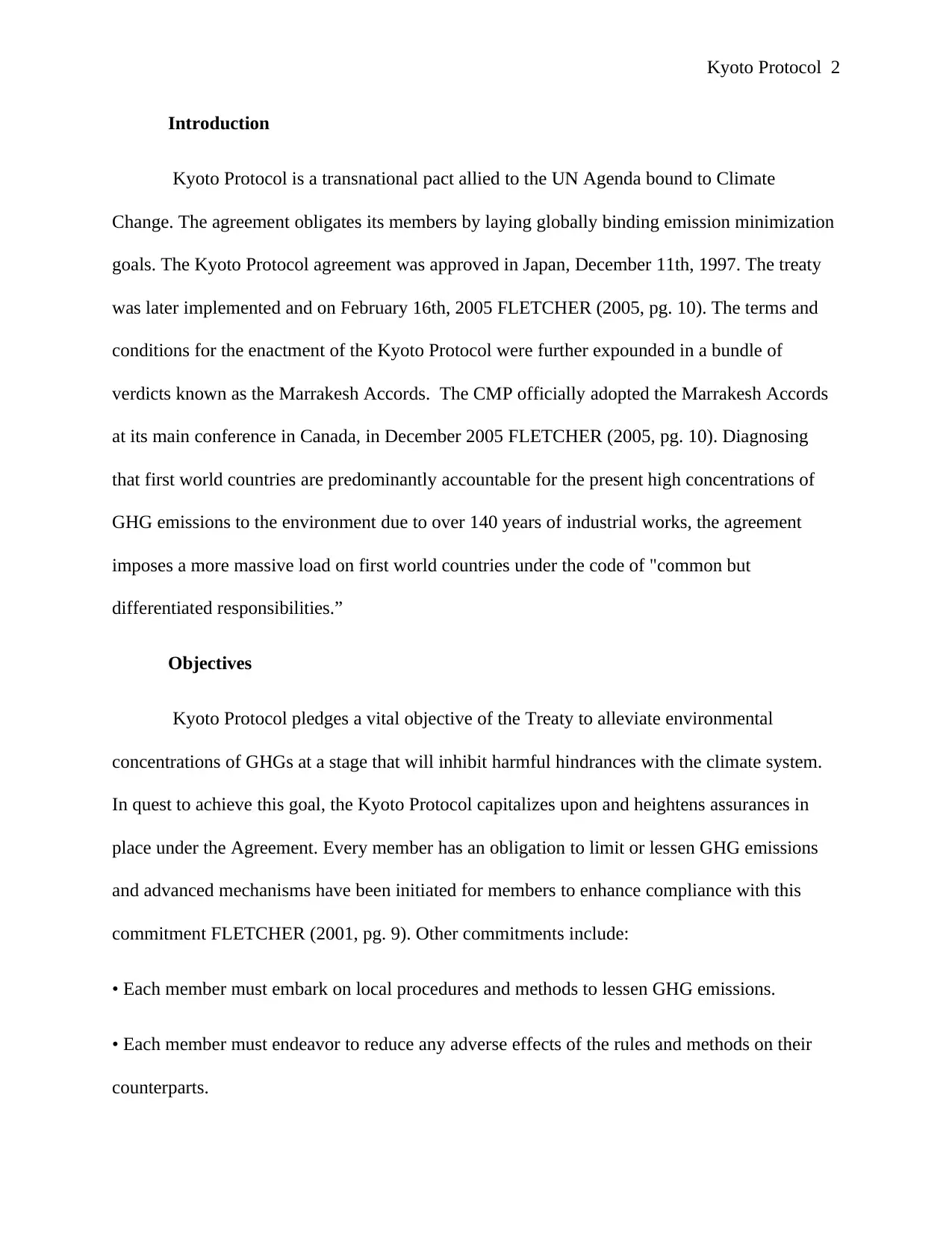
Kyoto Protocol 2
Introduction
Kyoto Protocol is a transnational pact allied to the UN Agenda bound to Climate
Change. The agreement obligates its members by laying globally binding emission minimization
goals. The Kyoto Protocol agreement was approved in Japan, December 11th, 1997. The treaty
was later implemented and on February 16th, 2005 FLETCHER (2005, pg. 10). The terms and
conditions for the enactment of the Kyoto Protocol were further expounded in a bundle of
verdicts known as the Marrakesh Accords. The CMP officially adopted the Marrakesh Accords
at its main conference in Canada, in December 2005 FLETCHER (2005, pg. 10). Diagnosing
that first world countries are predominantly accountable for the present high concentrations of
GHG emissions to the environment due to over 140 years of industrial works, the agreement
imposes a more massive load on first world countries under the code of "common but
differentiated responsibilities.”
Objectives
Kyoto Protocol pledges a vital objective of the Treaty to alleviate environmental
concentrations of GHGs at a stage that will inhibit harmful hindrances with the climate system.
In quest to achieve this goal, the Kyoto Protocol capitalizes upon and heightens assurances in
place under the Agreement. Every member has an obligation to limit or lessen GHG emissions
and advanced mechanisms have been initiated for members to enhance compliance with this
commitment FLETCHER (2001, pg. 9). Other commitments include:
• Each member must embark on local procedures and methods to lessen GHG emissions.
• Each member must endeavor to reduce any adverse effects of the rules and methods on their
counterparts.
Introduction
Kyoto Protocol is a transnational pact allied to the UN Agenda bound to Climate
Change. The agreement obligates its members by laying globally binding emission minimization
goals. The Kyoto Protocol agreement was approved in Japan, December 11th, 1997. The treaty
was later implemented and on February 16th, 2005 FLETCHER (2005, pg. 10). The terms and
conditions for the enactment of the Kyoto Protocol were further expounded in a bundle of
verdicts known as the Marrakesh Accords. The CMP officially adopted the Marrakesh Accords
at its main conference in Canada, in December 2005 FLETCHER (2005, pg. 10). Diagnosing
that first world countries are predominantly accountable for the present high concentrations of
GHG emissions to the environment due to over 140 years of industrial works, the agreement
imposes a more massive load on first world countries under the code of "common but
differentiated responsibilities.”
Objectives
Kyoto Protocol pledges a vital objective of the Treaty to alleviate environmental
concentrations of GHGs at a stage that will inhibit harmful hindrances with the climate system.
In quest to achieve this goal, the Kyoto Protocol capitalizes upon and heightens assurances in
place under the Agreement. Every member has an obligation to limit or lessen GHG emissions
and advanced mechanisms have been initiated for members to enhance compliance with this
commitment FLETCHER (2001, pg. 9). Other commitments include:
• Each member must embark on local procedures and methods to lessen GHG emissions.
• Each member must endeavor to reduce any adverse effects of the rules and methods on their
counterparts.
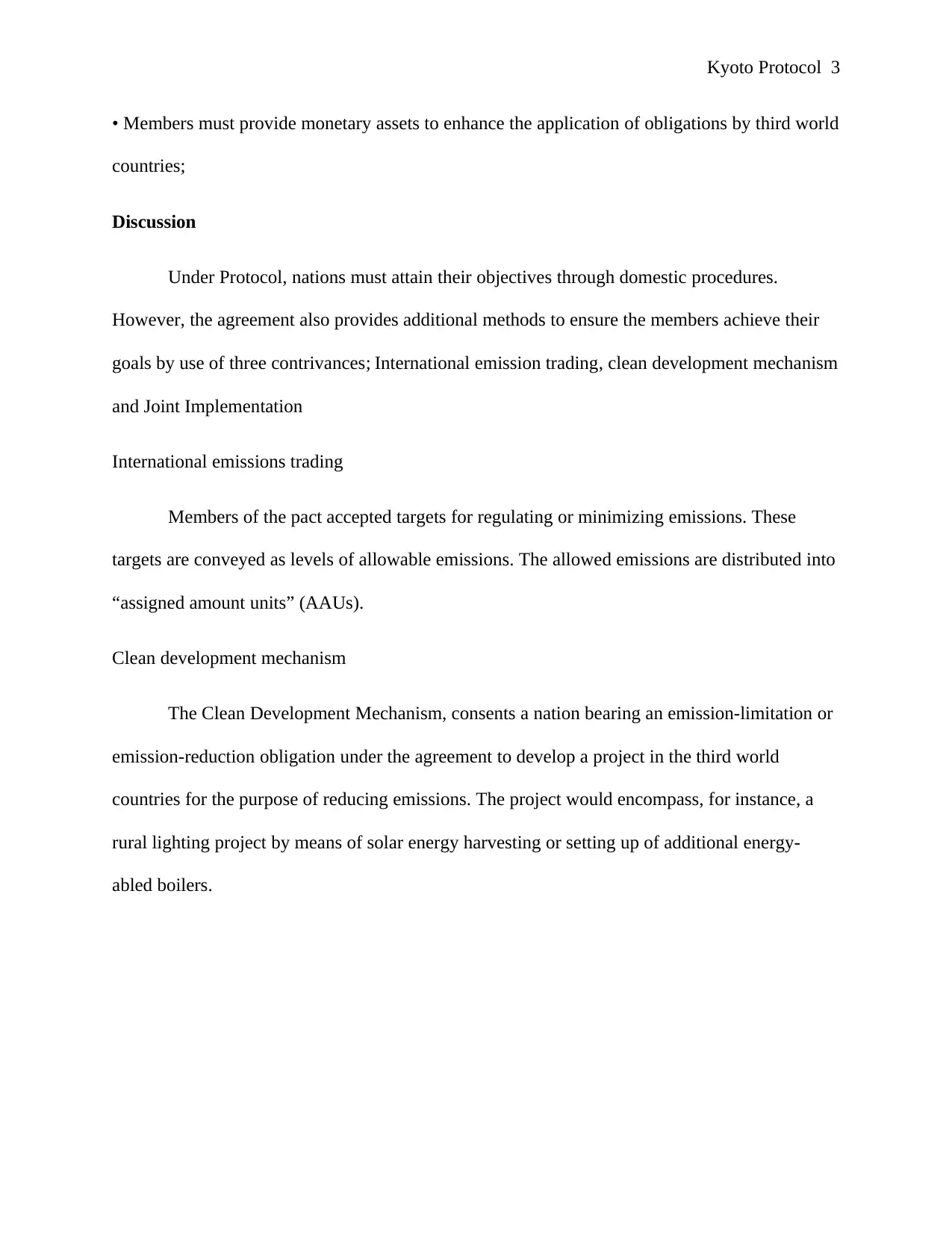
Kyoto Protocol 3
• Members must provide monetary assets to enhance the application of obligations by third world
countries;
Discussion
Under Protocol, nations must attain their objectives through domestic procedures.
However, the agreement also provides additional methods to ensure the members achieve their
goals by use of three contrivances; International emission trading, clean development mechanism
and Joint Implementation
International emissions trading
Members of the pact accepted targets for regulating or minimizing emissions. These
targets are conveyed as levels of allowable emissions. The allowed emissions are distributed into
“assigned amount units” (AAUs).
Clean development mechanism
The Clean Development Mechanism, consents a nation bearing an emission-limitation or
emission-reduction obligation under the agreement to develop a project in the third world
countries for the purpose of reducing emissions. The project would encompass, for instance, a
rural lighting project by means of solar energy harvesting or setting up of additional energy-
abled boilers.
• Members must provide monetary assets to enhance the application of obligations by third world
countries;
Discussion
Under Protocol, nations must attain their objectives through domestic procedures.
However, the agreement also provides additional methods to ensure the members achieve their
goals by use of three contrivances; International emission trading, clean development mechanism
and Joint Implementation
International emissions trading
Members of the pact accepted targets for regulating or minimizing emissions. These
targets are conveyed as levels of allowable emissions. The allowed emissions are distributed into
“assigned amount units” (AAUs).
Clean development mechanism
The Clean Development Mechanism, consents a nation bearing an emission-limitation or
emission-reduction obligation under the agreement to develop a project in the third world
countries for the purpose of reducing emissions. The project would encompass, for instance, a
rural lighting project by means of solar energy harvesting or setting up of additional energy-
abled boilers.
⊘ This is a preview!⊘
Do you want full access?
Subscribe today to unlock all pages.

Trusted by 1+ million students worldwide
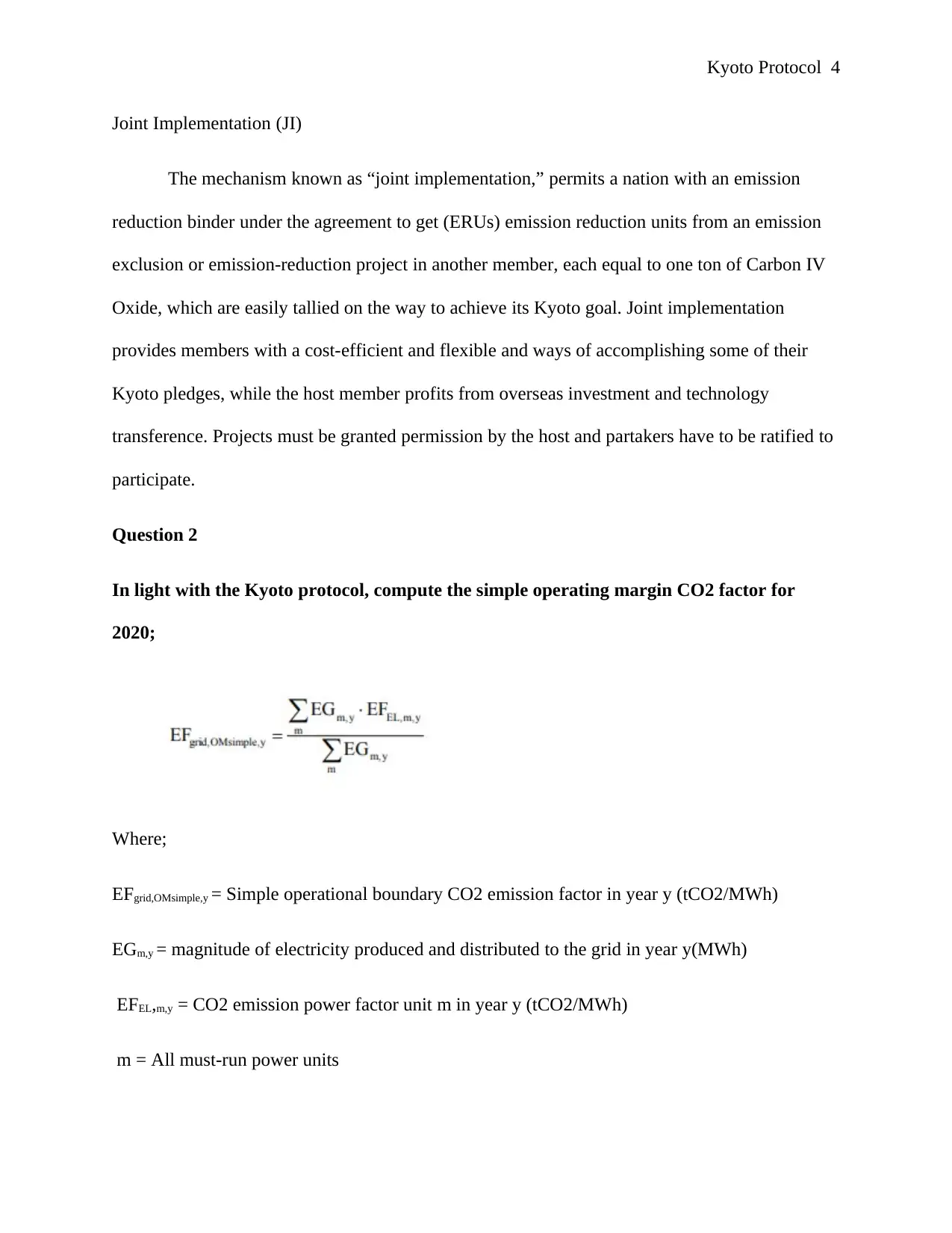
Kyoto Protocol 4
Joint Implementation (JI)
The mechanism known as “joint implementation,” permits a nation with an emission
reduction binder under the agreement to get (ERUs) emission reduction units from an emission
exclusion or emission-reduction project in another member, each equal to one ton of Carbon IV
Oxide, which are easily tallied on the way to achieve its Kyoto goal. Joint implementation
provides members with a cost-efficient and flexible and ways of accomplishing some of their
Kyoto pledges, while the host member profits from overseas investment and technology
transference. Projects must be granted permission by the host and partakers have to be ratified to
participate.
Question 2
In light with the Kyoto protocol, compute the simple operating margin CO2 factor for
2020;
Where;
EFgrid,OMsimple,y = Simple operational boundary CO2 emission factor in year y (tCO2/MWh)
EGm,y = magnitude of electricity produced and distributed to the grid in year y(MWh)
EFEL,m,y = CO2 emission power factor unit m in year y (tCO2/MWh)
m = All must-run power units
Joint Implementation (JI)
The mechanism known as “joint implementation,” permits a nation with an emission
reduction binder under the agreement to get (ERUs) emission reduction units from an emission
exclusion or emission-reduction project in another member, each equal to one ton of Carbon IV
Oxide, which are easily tallied on the way to achieve its Kyoto goal. Joint implementation
provides members with a cost-efficient and flexible and ways of accomplishing some of their
Kyoto pledges, while the host member profits from overseas investment and technology
transference. Projects must be granted permission by the host and partakers have to be ratified to
participate.
Question 2
In light with the Kyoto protocol, compute the simple operating margin CO2 factor for
2020;
Where;
EFgrid,OMsimple,y = Simple operational boundary CO2 emission factor in year y (tCO2/MWh)
EGm,y = magnitude of electricity produced and distributed to the grid in year y(MWh)
EFEL,m,y = CO2 emission power factor unit m in year y (tCO2/MWh)
m = All must-run power units
Paraphrase This Document
Need a fresh take? Get an instant paraphrase of this document with our AI Paraphraser
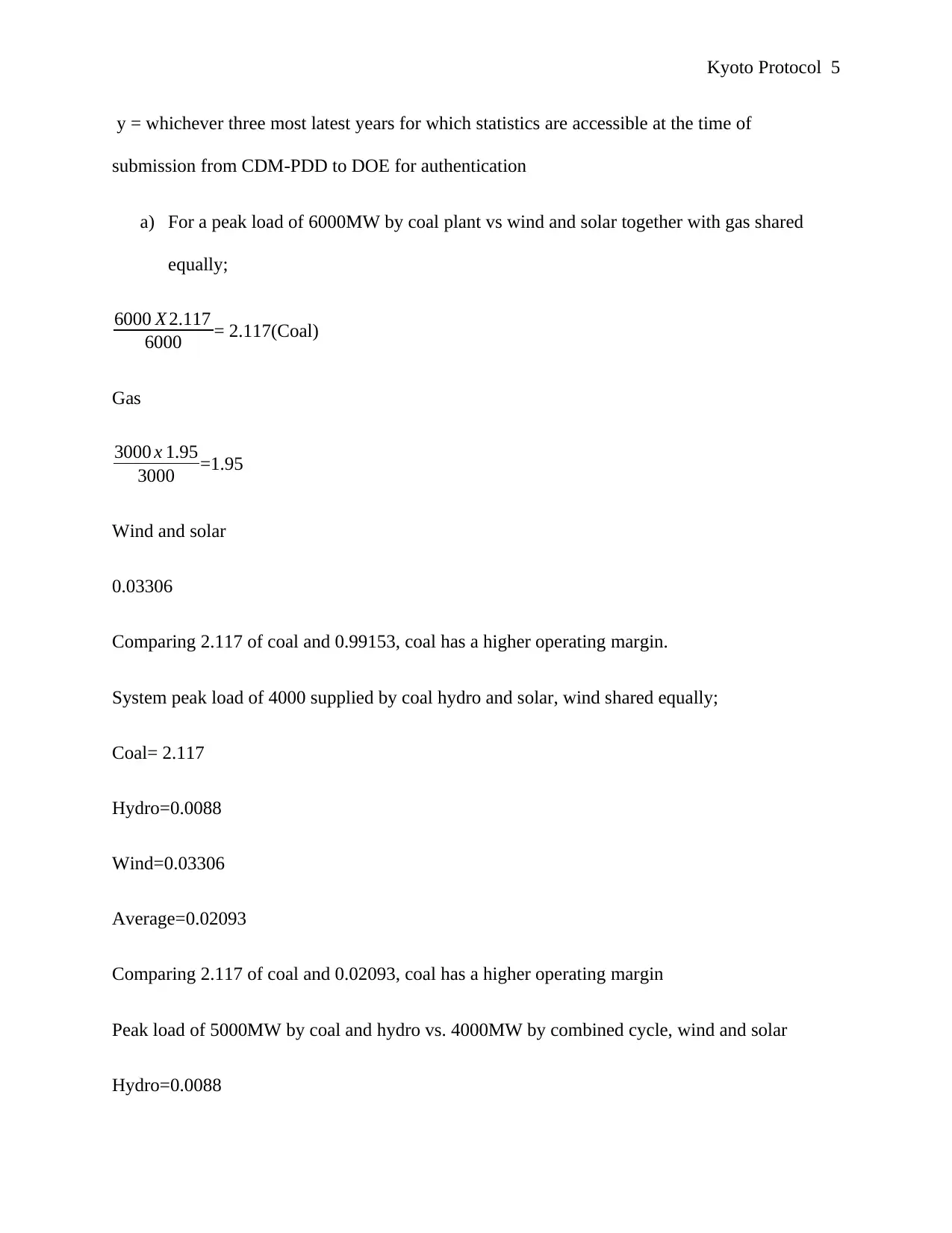
Kyoto Protocol 5
y = whichever three most latest years for which statistics are accessible at the time of
submission from CDM-PDD to DOE for authentication
a) For a peak load of 6000MW by coal plant vs wind and solar together with gas shared
equally;
6000 X 2.117
6000 = 2.117(Coal)
Gas
3000 x 1.95
3000 =1.95
Wind and solar
0.03306
Comparing 2.117 of coal and 0.99153, coal has a higher operating margin.
System peak load of 4000 supplied by coal hydro and solar, wind shared equally;
Coal= 2.117
Hydro=0.0088
Wind=0.03306
Average=0.02093
Comparing 2.117 of coal and 0.02093, coal has a higher operating margin
Peak load of 5000MW by coal and hydro vs. 4000MW by combined cycle, wind and solar
Hydro=0.0088
y = whichever three most latest years for which statistics are accessible at the time of
submission from CDM-PDD to DOE for authentication
a) For a peak load of 6000MW by coal plant vs wind and solar together with gas shared
equally;
6000 X 2.117
6000 = 2.117(Coal)
Gas
3000 x 1.95
3000 =1.95
Wind and solar
0.03306
Comparing 2.117 of coal and 0.99153, coal has a higher operating margin.
System peak load of 4000 supplied by coal hydro and solar, wind shared equally;
Coal= 2.117
Hydro=0.0088
Wind=0.03306
Average=0.02093
Comparing 2.117 of coal and 0.02093, coal has a higher operating margin
Peak load of 5000MW by coal and hydro vs. 4000MW by combined cycle, wind and solar
Hydro=0.0088
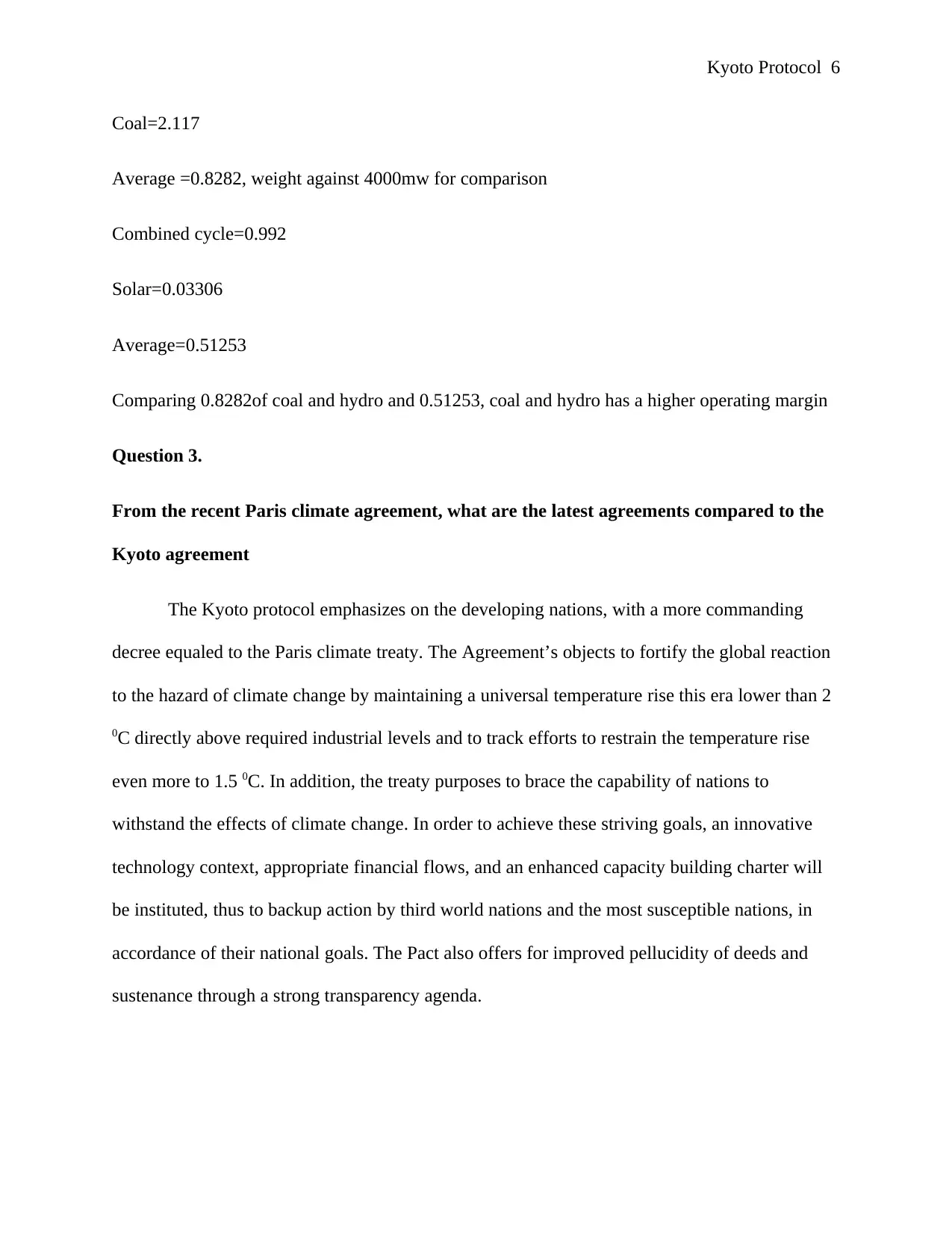
Kyoto Protocol 6
Coal=2.117
Average =0.8282, weight against 4000mw for comparison
Combined cycle=0.992
Solar=0.03306
Average=0.51253
Comparing 0.8282of coal and hydro and 0.51253, coal and hydro has a higher operating margin
Question 3.
From the recent Paris climate agreement, what are the latest agreements compared to the
Kyoto agreement
The Kyoto protocol emphasizes on the developing nations, with a more commanding
decree equaled to the Paris climate treaty. The Agreement’s objects to fortify the global reaction
to the hazard of climate change by maintaining a universal temperature rise this era lower than 2
0C directly above required industrial levels and to track efforts to restrain the temperature rise
even more to 1.5 0C. In addition, the treaty purposes to brace the capability of nations to
withstand the effects of climate change. In order to achieve these striving goals, an innovative
technology context, appropriate financial flows, and an enhanced capacity building charter will
be instituted, thus to backup action by third world nations and the most susceptible nations, in
accordance of their national goals. The Pact also offers for improved pellucidity of deeds and
sustenance through a strong transparency agenda.
Coal=2.117
Average =0.8282, weight against 4000mw for comparison
Combined cycle=0.992
Solar=0.03306
Average=0.51253
Comparing 0.8282of coal and hydro and 0.51253, coal and hydro has a higher operating margin
Question 3.
From the recent Paris climate agreement, what are the latest agreements compared to the
Kyoto agreement
The Kyoto protocol emphasizes on the developing nations, with a more commanding
decree equaled to the Paris climate treaty. The Agreement’s objects to fortify the global reaction
to the hazard of climate change by maintaining a universal temperature rise this era lower than 2
0C directly above required industrial levels and to track efforts to restrain the temperature rise
even more to 1.5 0C. In addition, the treaty purposes to brace the capability of nations to
withstand the effects of climate change. In order to achieve these striving goals, an innovative
technology context, appropriate financial flows, and an enhanced capacity building charter will
be instituted, thus to backup action by third world nations and the most susceptible nations, in
accordance of their national goals. The Pact also offers for improved pellucidity of deeds and
sustenance through a strong transparency agenda.
⊘ This is a preview!⊘
Do you want full access?
Subscribe today to unlock all pages.

Trusted by 1+ million students worldwide
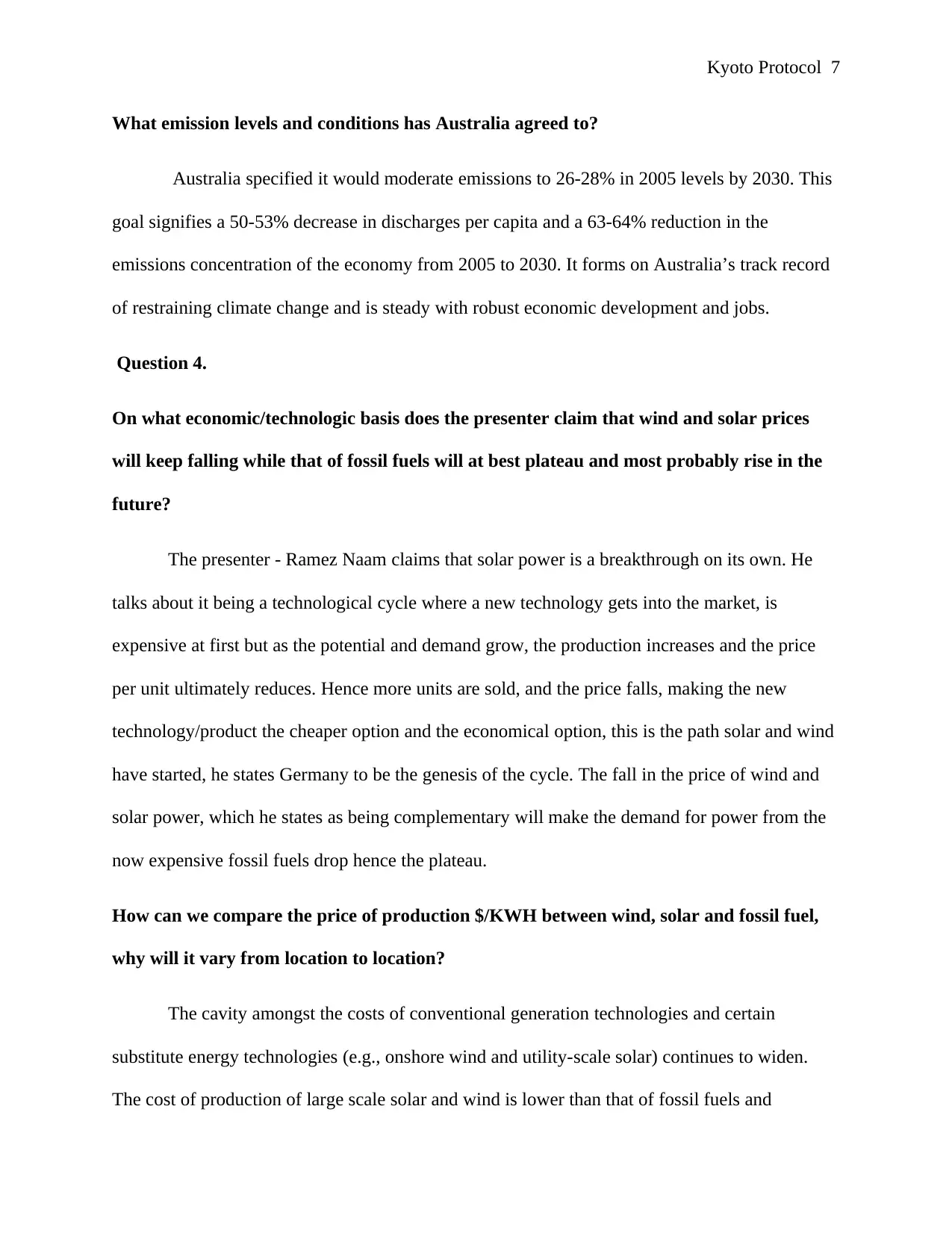
Kyoto Protocol 7
What emission levels and conditions has Australia agreed to?
Australia specified it would moderate emissions to 26-28% in 2005 levels by 2030. This
goal signifies a 50-53% decrease in discharges per capita and a 63-64% reduction in the
emissions concentration of the economy from 2005 to 2030. It forms on Australia’s track record
of restraining climate change and is steady with robust economic development and jobs.
Question 4.
On what economic/technologic basis does the presenter claim that wind and solar prices
will keep falling while that of fossil fuels will at best plateau and most probably rise in the
future?
The presenter - Ramez Naam claims that solar power is a breakthrough on its own. He
talks about it being a technological cycle where a new technology gets into the market, is
expensive at first but as the potential and demand grow, the production increases and the price
per unit ultimately reduces. Hence more units are sold, and the price falls, making the new
technology/product the cheaper option and the economical option, this is the path solar and wind
have started, he states Germany to be the genesis of the cycle. The fall in the price of wind and
solar power, which he states as being complementary will make the demand for power from the
now expensive fossil fuels drop hence the plateau.
How can we compare the price of production $/KWH between wind, solar and fossil fuel,
why will it vary from location to location?
The cavity amongst the costs of conventional generation technologies and certain
substitute energy technologies (e.g., onshore wind and utility-scale solar) continues to widen.
The cost of production of large scale solar and wind is lower than that of fossil fuels and
What emission levels and conditions has Australia agreed to?
Australia specified it would moderate emissions to 26-28% in 2005 levels by 2030. This
goal signifies a 50-53% decrease in discharges per capita and a 63-64% reduction in the
emissions concentration of the economy from 2005 to 2030. It forms on Australia’s track record
of restraining climate change and is steady with robust economic development and jobs.
Question 4.
On what economic/technologic basis does the presenter claim that wind and solar prices
will keep falling while that of fossil fuels will at best plateau and most probably rise in the
future?
The presenter - Ramez Naam claims that solar power is a breakthrough on its own. He
talks about it being a technological cycle where a new technology gets into the market, is
expensive at first but as the potential and demand grow, the production increases and the price
per unit ultimately reduces. Hence more units are sold, and the price falls, making the new
technology/product the cheaper option and the economical option, this is the path solar and wind
have started, he states Germany to be the genesis of the cycle. The fall in the price of wind and
solar power, which he states as being complementary will make the demand for power from the
now expensive fossil fuels drop hence the plateau.
How can we compare the price of production $/KWH between wind, solar and fossil fuel,
why will it vary from location to location?
The cavity amongst the costs of conventional generation technologies and certain
substitute energy technologies (e.g., onshore wind and utility-scale solar) continues to widen.
The cost of production of large scale solar and wind is lower than that of fossil fuels and
Paraphrase This Document
Need a fresh take? Get an instant paraphrase of this document with our AI Paraphraser
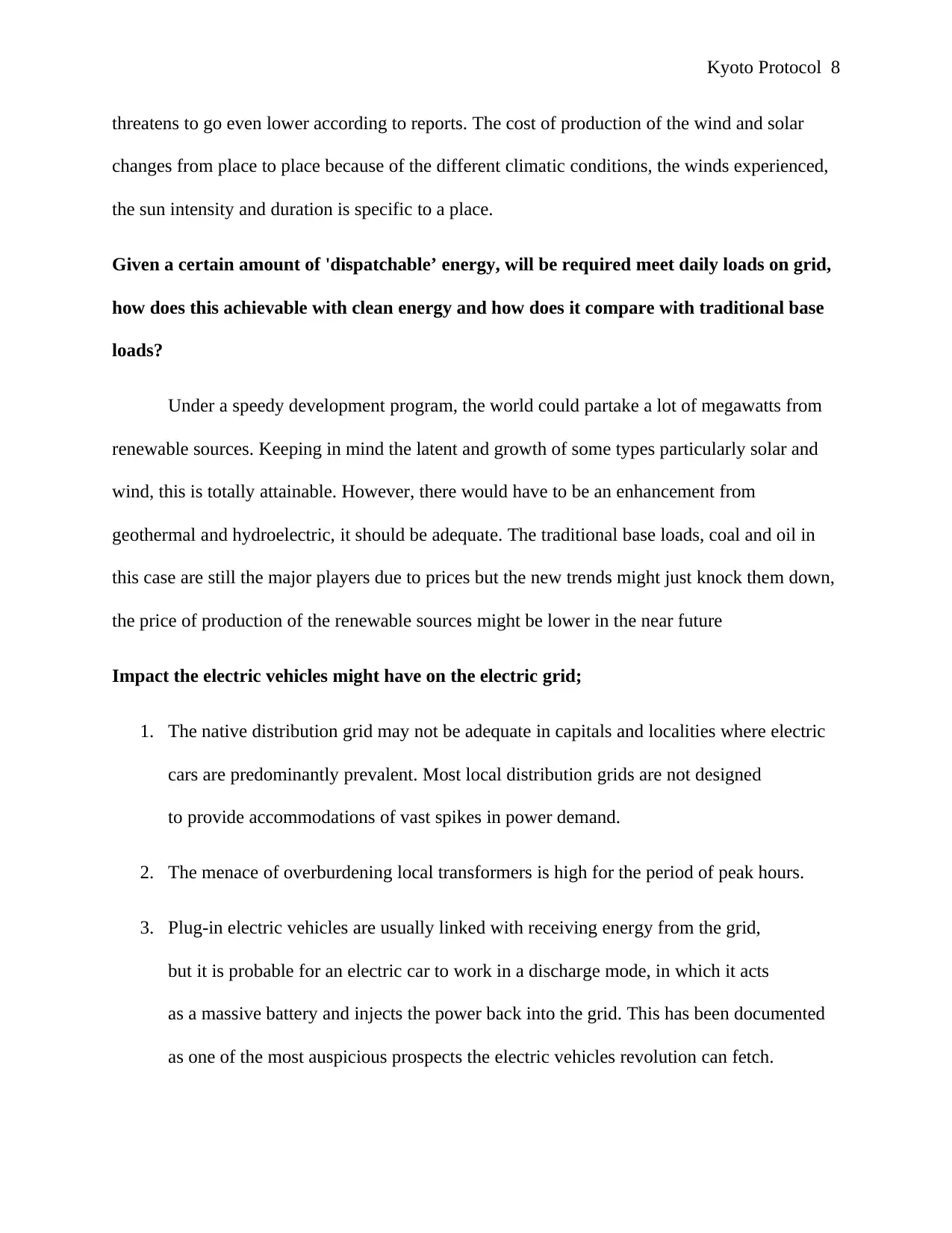
Kyoto Protocol 8
threatens to go even lower according to reports. The cost of production of the wind and solar
changes from place to place because of the different climatic conditions, the winds experienced,
the sun intensity and duration is specific to a place.
Given a certain amount of 'dispatchable’ energy, will be required meet daily loads on grid,
how does this achievable with clean energy and how does it compare with traditional base
loads?
Under a speedy development program, the world could partake a lot of megawatts from
renewable sources. Keeping in mind the latent and growth of some types particularly solar and
wind, this is totally attainable. However, there would have to be an enhancement from
geothermal and hydroelectric, it should be adequate. The traditional base loads, coal and oil in
this case are still the major players due to prices but the new trends might just knock them down,
the price of production of the renewable sources might be lower in the near future
Impact the electric vehicles might have on the electric grid;
1. The native distribution grid may not be adequate in capitals and localities where electric
cars are predominantly prevalent. Most local distribution grids are not designed
to provide accommodations of vast spikes in power demand.
2. The menace of overburdening local transformers is high for the period of peak hours.
3. Plug-in electric vehicles are usually linked with receiving energy from the grid,
but it is probable for an electric car to work in a discharge mode, in which it acts
as a massive battery and injects the power back into the grid. This has been documented
as one of the most auspicious prospects the electric vehicles revolution can fetch.
threatens to go even lower according to reports. The cost of production of the wind and solar
changes from place to place because of the different climatic conditions, the winds experienced,
the sun intensity and duration is specific to a place.
Given a certain amount of 'dispatchable’ energy, will be required meet daily loads on grid,
how does this achievable with clean energy and how does it compare with traditional base
loads?
Under a speedy development program, the world could partake a lot of megawatts from
renewable sources. Keeping in mind the latent and growth of some types particularly solar and
wind, this is totally attainable. However, there would have to be an enhancement from
geothermal and hydroelectric, it should be adequate. The traditional base loads, coal and oil in
this case are still the major players due to prices but the new trends might just knock them down,
the price of production of the renewable sources might be lower in the near future
Impact the electric vehicles might have on the electric grid;
1. The native distribution grid may not be adequate in capitals and localities where electric
cars are predominantly prevalent. Most local distribution grids are not designed
to provide accommodations of vast spikes in power demand.
2. The menace of overburdening local transformers is high for the period of peak hours.
3. Plug-in electric vehicles are usually linked with receiving energy from the grid,
but it is probable for an electric car to work in a discharge mode, in which it acts
as a massive battery and injects the power back into the grid. This has been documented
as one of the most auspicious prospects the electric vehicles revolution can fetch.
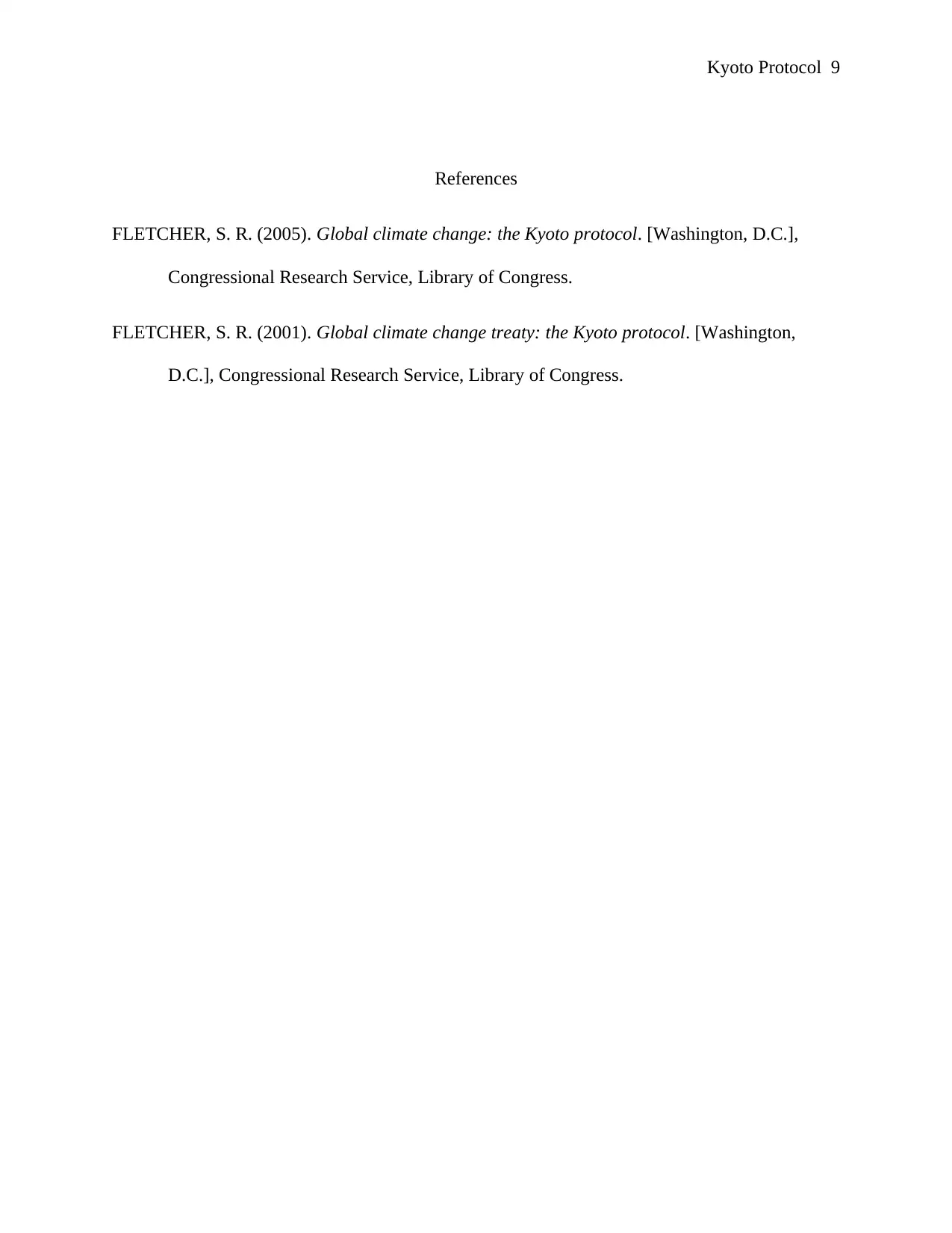
Kyoto Protocol 9
References
FLETCHER, S. R. (2005). Global climate change: the Kyoto protocol. [Washington, D.C.],
Congressional Research Service, Library of Congress.
FLETCHER, S. R. (2001). Global climate change treaty: the Kyoto protocol. [Washington,
D.C.], Congressional Research Service, Library of Congress.
References
FLETCHER, S. R. (2005). Global climate change: the Kyoto protocol. [Washington, D.C.],
Congressional Research Service, Library of Congress.
FLETCHER, S. R. (2001). Global climate change treaty: the Kyoto protocol. [Washington,
D.C.], Congressional Research Service, Library of Congress.
⊘ This is a preview!⊘
Do you want full access?
Subscribe today to unlock all pages.

Trusted by 1+ million students worldwide
1 out of 9
Your All-in-One AI-Powered Toolkit for Academic Success.
+13062052269
info@desklib.com
Available 24*7 on WhatsApp / Email
![[object Object]](/_next/static/media/star-bottom.7253800d.svg)
Unlock your academic potential
Copyright © 2020–2025 A2Z Services. All Rights Reserved. Developed and managed by ZUCOL.


